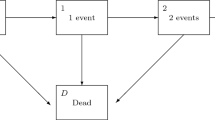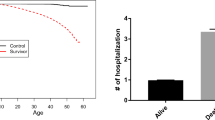Abstract
In an attempt to provide tools for assessing hospital utilization, this paper extends well-known models for recurrent events to address non-negligible event duration and presents a procedure for estimating the model parameters. The model extension is natural and easy to understand. Asymptotic properties of the associated inferences are derived adapting the well-developed methods based on the counting process formulation. Several specifications of the proposed modeling are illustrated with the hospitalization records of childhood cancer survivors from a health care insurance system that motivated this research. The usefulness and robustness of the proposed approach is demonstrated numerically via simulation.
Similar content being viewed by others
References
Andersen PK, Borgan O, Gill RD, Keiding N (1992) Statistical models based on counting processes. Springer, New York
Andersen PK, Gill RD (1982) Cox’s regression model for counting processes: a large sample study. Anna Stat 10: 1100–1120
Cai J, Schaubel DE (2004) Marginal means/rates models for multiple type recurrent event data. Lifetime Data Anal 10: 121–138
Cook RJ, Lawless JF (2007) The statistical analysis of recurrent events. Springer, New York
Cox DR (1975) Partial likelihood. Biometrika 62: 269–276
Fleming TR, Harrington DP (1991) Counting processes and survival analysis. Wiley, New York
Ghosh D, Lin DY (2003) Semiparametric analysis of recurrent events data in the presence of dependent censoring. Biometrics 59: 877–885
Grambsch P, Therneau T (1994) Proportional hazards tests and diagnostics based on weighted residuals. Biometrika 81: 515–526
Kalbfleisch JD, Prentice RL (1980) The statistical analysis of failure time data. Wiley, New York
Kelly PJ, Lim LL-Y (2000) Survival analysis for recurrent event data: an application to childhood infectious diseases. Stat Med 19: 12–33
Lawless JF, Nadeau C (1995) Some simple robust methods for the analysis of recurrent events. Technometrics 37: 158–168
Lee MLT, Whitmore GA (2006) Threshold regression for survival analysis: modeling event times by a stochastic process reaching a boundary. Stat Sci 21: 501–513
Lin DY, Wei LJ, Yang I, Ying Z (2000) Semiparametric regression for the mean and rate functions of recurrent events. J R Stats Soc, Series B 62: 711–730
MaCarthur AC, Spinelli JJ, Rogers P, Goddard KJ, Abanto Z, McBride ML (2007a) Mortality among 5-year survivors of cancer diagnosed during childhood or adolescence in British Columbia, Canada. Pediatr Blood Cancer 48(4): 460–467
MaCarthur AC, Spinelli JJ, Rogers P, Goddard KJ, Abanto Z, McBride ML (2007b) Risk of a second malignant neoplasm among 5-year survivors of cancer in childhood and adolescence in British Columbia, Canada. Pediatr Blood Cancer 48(4): 453–459
Miloslavsky S, Keles S, van der Laan MJ, Butler S (2004) Recurrent events analysis in the presence of time-dependent covariates and dependent censoring. J R Stats Soc, Series B 66: 239–257
Oakes D (1992) Frailty models for multiple event times. In: Klein J, Goel P (eds) Survival analysis: state of the art. Kluwer, Dordrecht, pp 371–379
Pepe MS, Cai J (1993) Some graphical displays and marginal regression analyses for recurrent failure times and time dependent covariates. J Am Stats Assoc 88: 811–820
Prentice RL, Williams BJ, Peterson AV (1981) On the regression analysis of multivariate failure time data. Biometrika 68: 373–379
Sun J (2006) The statistical analysis of interval-censored failure time data. Springer, New York
Therneau T, Grambsch P (2000) Modeling survival data: extending the cox model. Springer, New York
Twisk JWR, Smidt N, de Vente W (2005) Applied analysis of recurrent events: a practical overview. J Epidemiol Community Health 59: 706–710
Wang MC, Qin J, Chiang CT (2001) Analyzing recurrent event data with informative censoring. J Am Stats Assoc 96: 1057–1065
Ying SC (2006) Generalized longitudinal data analysis, with application to evaluating hospital utilization based on administrative database. Master’s Thesis, Department of Statistics and Actuarial Science, Simon Fraser University
Author information
Authors and Affiliations
Corresponding author
Rights and permissions
About this article
Cite this article
Hu, X.J., Lorenzi, M., Spinelli, J.J. et al. Analysis of recurrent events with non-negligible event duration, with application to assessing hospital utilization. Lifetime Data Anal 17, 215–233 (2011). https://doi.org/10.1007/s10985-010-9183-8
Received:
Accepted:
Published:
Issue Date:
DOI: https://doi.org/10.1007/s10985-010-9183-8




